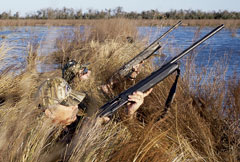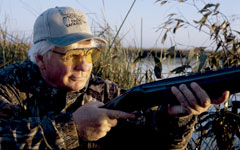November 03, 2010
By Nick Sisley
It would improve one's success to have the shotgun in a more ready position -- in the blind.
By Nick Sisley
 These hunters have their shotguns in ideal pre-shot positions. |
I've been in the blind with guides who didn't pick up their gun until after their client's first shot went off. And I've seen such guys shoot exceptionally, even at long-range ducks and geese. Of course, I've also been with guides who shot before his clients, but let's not go there.
My objective here is to convince you that the more you have your shotgun in the right position initially, the better your chances are for connecting. Sporting clays competition no longer requires a dismounted gun, which is a shame because proper gun mounting is a big part of successful and consistent shotgun shooting. Of course, there's a great deal more to making a proper gun mount than meets the untrained eye. But let's not go there either -- at least for right now.
F.I.T.A.S.C. (another formal, competitive clay target game) does require the shooter to start with the gun well down off the shoulder, so these competitors have to make a consistent gun mount to achieve any kind of success. If you ever have a chance to watch a F.I.T.A.S.C shooter, or a person who shoots sporting clays with the gun down, try to be extra observant. These shooters do their level best to put the muzzle in the most advantageous position. They also start with the lowered buttstock in exactly the same position time after time.
Advertisement
How do we relate what clay target shooters are doing to hunters in the duck blind, the goose pit, from behind cypress trees in the timber? Obviously, in hunting situations we don't always have the opportunity to get the gun's muzzle where we want it right from the get-go. Further, we often aren't holding the gun in the best position for executing a proper gun mount.
But sometimes we are. I think having the gun in the proper position can often be attained when duck and goose shooting. The birds are in the air, as opposed to being totally or partially hidden by vegetation. Often we're watching them, so we know where they are at "Take 'em" time, which sometimes allows us to start off with the gun's muzzle in a great position. Since we can anticipate shooting at any second we can also have the buttstock in perfect position to make a consistent and proper gun mount.
How do we pull all this off? It's best to experiment with your gun mount, with an unloaded gun, and do it over and over again. What works as an easy gun mount for one person may not be as great for another. Here's what works for me. Give it a try. If it doesn't work so well for you, experiment some more to see what does work best.
Advertisement
I like to have the top part of the butt of the shotgun tucked just a bit inside my armpit. If you're worried about gun movement when birds are working, and we all should be, maybe you can get the stock just inside your armpit as the birds swing behind the blind. This position used to be too high in sporting clays before the new rules came into effect, and my suggested position is also too high for competition F.I.T.A.S.C. But, no matter, we're after ducks and geese. The advantage of this pre-mount position is that you know, mentally and physically, the position of the buttstock. Often we waterfowlers are wearing lots of clothes, making it all the easier for us to hang up the buttstock as we mount, making a successful shot much more difficult. Starting as I've suggested, with the top of the buttstock tucked into the bottom of your armpit -- you can feel where it is -- you'll be much less likely to hang that stock on clothing as you mount. Of course, practicing your gun mount from this start position over and over, with an unloaded gun, is essential, especially if the positioning is new to you.
Now that we have the gun perfectly positioned, we can easily make a consistent and proper gun mount. What's next?
Continued -- click on page link below.
Try to make the muzzle move smoothly during your practice-mount sessions. I find that when I hold the pistol grip tightly it's easy for me to have that muzzle dip down as I bring the gun toward my shoulder. Consequently, to avoid the muzzle-dip, I grasp the pistol grip of the gun lightly. As I mount on an imaginary straightaway bird I use the heel of my hand on the fore-end to help raise the buttstock to my shoulder. This seems to cut down on this muzzle-dipping tendency.
 Ducks coming in low allow the hunter to ready the buttstock into perfect position. |
But I also like to practice a lot on imaginary crossing shots. I think it's important here to practice moving the gun, right or left, (or whichever bird-path direction you're imagining) before you start the gun to your shoulder. Starting the swing first in a real hunting situation helps you from getting too far behind the bird, which can happen if you're too interested in getting the buttstock to your shoulder before you start your swing. Immediately after you start swinging, begin raising the gun's butt toward your shoulder -- again relying on the heel of the fore-end hand to accomplish this.
Next, it pays to be looking at the birds as they work. Although this may spook a few birds, I'd sooner miss out on a shot than miss the action of ducks and geese reacting positively to the decoy spread and our calling. But I realize, too, that I might be in the minority on this point. One tactic you can utilize to avoid being spotted by the quarry: use face paint. Maybe waterfowl guides will start carrying camo face paint in their shell bag just for this purpose. A facemask is also a possibility here. If you wear glasses, get the type that stretches around your neck and pulls up to cover your ears and mouth. Your hat will shade nose and eyes.
But let's say we're looking at the birds, and it's time. No pre-practice is necessary -- except that, where possible, and without spooking the birds, ease the gun's muzzle more toward where the fowl are going to be when the shot is called. Now -- as in sporting clays and/or F.I.T.A.S.C. -- your muzzle is perfectly positioned, your gun is being held in such a manner that your gun-mount is going to be perfect.
Let me go back to clay target shooting. The target can be broken if we start the muzzle from virtually any position. But, and this is a big but, it's far easier to make a good shot -- clay bird or feathered -- if the muzzle is in a great place to start with. Put the gun over your shoulder or in the crook of your arm, and from that position try to hit a fast-crossing clay target. Call for the bird and try to get the gun into act
ion. You'll be anything but smooth. Even if you do break that bird, you won't do it very consistently.
I realize that getting the buttstock perfectly placed while the geese are circling, or coming in but still out of range, and getting the muzzle positioned properly to make the shot easier, is pretty basic stuff. Some of you might already do a lot of this naturally, without giving it much thought. If you haven't given these suggestions much thought, I hope you will. Get the buttstock exactly where it works best for you to make a great gun-mount. Get the muzzle in the most advantageous position for where the birds are and where you think they're going to be when you pull the trigger. Do all this before it's time to swing into action. It makes the shooting easier.
Nick Sisley can be reached at nicksisley@hotmail.com.

